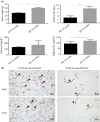Growth arrest-specific 6 modulates adiponectin expression and insulin resistance in adipose tissue
- PMID: 32969596
- PMCID: PMC8015836
- DOI: 10.1111/jdi.13412
Growth arrest-specific 6 modulates adiponectin expression and insulin resistance in adipose tissue
Abstract
Aims/introduction: Obesity is characterized by disturbed adipocytokine expression and insulin resistance in adipocytes. Growth arrest-specific 6 (GAS6) is a gene encoding the Gas6 protein, which is expressed in fibroblasts, and its related signaling might be associated with adipose tissue inflammation, glucose intolerance and insulin resistance. The aim of this study was to investigate the associations among Gas6, adipocytokines and insulin resistance in adipocytes.
Materials and methods: Mature Simpson Golabi Behmel Syndrome adipocytes were treated with high levels of insulin to mimic insulin resistance, and were examined for the expressions of Gas6, cytokines and adipocytokines from preadipocytes in differentiation. In an animal study, high-fat diet-induced obese mice were used to verify the Gas6 expression in vitro.
Results: During the differentiation of adipocytes, the expression of Gas6 gradually decreased, and was obviously downregulated with adipocyte inflammation and insulin resistance. Gas6 levels were found to be in proportion to the expression of adiponectin, which has been regarded as closely relevant to improved insulin sensitivity after metformin treatment. Similar results were also confirmed in the animal study.
Conclusions: Our results suggest that Gas6 might modulate the expression of adiponectin, and might therefore be associated with insulin resistance in adipose tissues.
Keywords: Adipocyte; Adiponectin; Gas6.
© 2020 The Authors. Journal of Diabetes Investigation published by Asian Association for the Study of Diabetes (AASD) and John Wiley & Sons Australia, Ltd.
Conflict of interest statement
The authors declare no conflict of interest.
Figures





References
MeSH terms
Substances
Grants and funding
- TSGH-C105-005-S03/Tri-Service General Hospital
- TSGH-C107-006-006-S02/Tri-Service General Hospital
- TSGH-C108-005-006-006-S02/Tri-Service General Hospital
- TSGH-C107-103/Tri-Service General Hospital
- TSGH-C108-143/Tri-Service General Hospital
- MAB-107-063/Tri-Service General Hospital
- MAB-108-045/Tri-Service General Hospital
- MAB-106-113/Tri-Service General Hospital
- MAB-108-046/Tri-Service General Hospital
- MOST 107-2314-B-016-007/Ministry of Science and Technology
- MOST 105-2314-B-016-040-MY3/Ministry of Science and Technology
- MOST 108-2314-B-016-033-MY2/Ministry of Science and Technology
- MOST 108-2314-B-016-019-MY3/Ministry of Science and Technology
- MOST 108-2314-B-016-013/Ministry of Science and Technology
LinkOut - more resources
Full Text Sources

